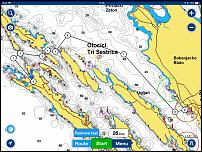Quote:
Originally Posted by Iron Dials

Can I ask those of you who operate ribs during the hours of darkness what rules of thumb you use regarding boat speed?
Whilst a lifeboat crew have a reason (and training) to travel without delay I'm wondering what limits "normal people" apply to be able to recognise sea state/avoid punishing passage in rougher water.
Even allowing for your night vision being maximised by reduced ambient light I see it as a challenge.
If any of you have experience I'd love to hear what you think and do.
|
Last summer in Croatia, Mick & I had cause to make a 25nm night passage to pick up Mick’s daughter from Zadar airport. We were in unfamiliar territory & neither of us had much experience of night-time boating, but at the time needs must. We had to pass between several un-inhabited / unlit islands. There is very little in the way of buoyage or lighthouses in the area. To cap it all, I’d left the SD card with the Navionics chart for the area, back at home on the kitchen table.....what could go wrong??
A call to my daughter back in the UK had her collecting the SD card from home & dropping it off with Micks daughter, so far so good.
We did the run to Zadar from Dugi Otok in daylight, making sure that the trails were enabled on the plotters on both boats. We made a point of ensuring that we stayed well clear of the coast/islands & made a note of any fishing gear, pots etc, dropping waypoints where necessary. I’d already plotted a course on Navionics on the IPad & made a note of distances & bearings & times to turn at given speeds.
We picked up Hannah (and the chart card[emoji106]) in Zadar & set off back to base, the first couple of miles was the worst until the night vision kicked in. You need to turn off all un-necessary lights & dim down the instruments as far as possible, even the reflection of our own nav lights off the console was annoying. Now I had the chart card, I could overlay our outward track onto the chart & just follow a reciprocal course. We used the few lit buoys that do exist, as waypoints to check that we were on course & that the GPS wasn’t telling fibs. The night was very clear & we had the benefit of good moonlight. The sea was mostly calm apart from a lumpy bit just outside Zadar. Once you relax & get in the groove, it was actually very enjoyable & we bowled along at around 20kn.
Probably not the text book way of doing things, but nobody died & we enjoyed the experience.
